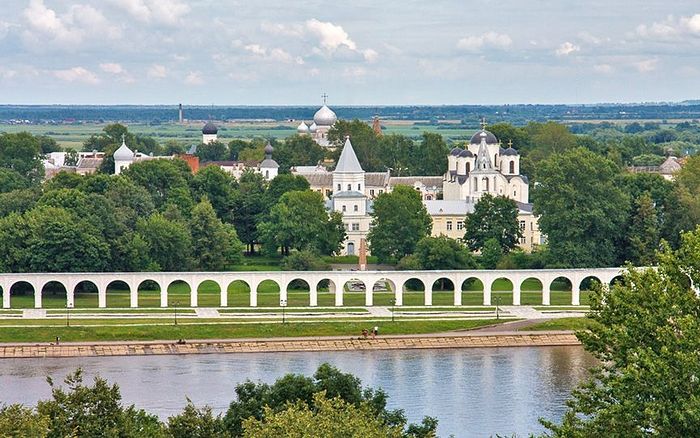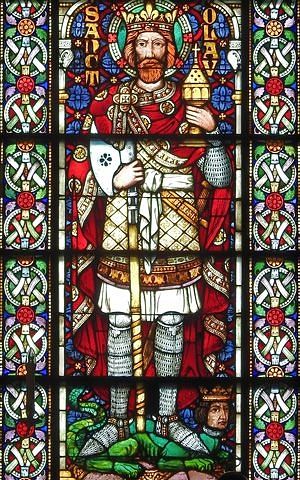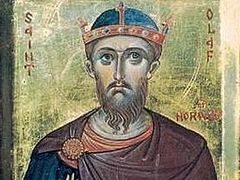Veliky Novgorod, Russia, November 15, 2018
One of the most popular hiking routs in Europe will soon expand into Russia to include Veliky Novgorod, where St. Olaf II, the 11th century ruler of Norway, lived for a time in exile.
As the Regional Ministry of Investment Policy page reported in late October, an agreement was reached in Finland by which the popular pilgrimage and tourist path St. Olaf’s Trail will expand to include Veliky Novgorod, and the tour company Novgorod Rus’ will be the coordinator of the “Route of St. Olaf in the Novgorod Province” project.
Every year, hundreds of thousands of people follow St. Olaf’s Trail, which requires about 25 days to cover, passing over land and water. It has been proposed to begin the Novgorod leg of the trail at Yaroslav’s Court where there was a Church of St. Olaf until the 14th century.
“Of course, we have a lot of work to do. The path needs to be improved. Tourists should see pedestrian zones, camping stops, bridges over small rivers and streams along the way,” explained Novgorod Rus’.
St. Olaf’s Trail is currently about 370 miles long, passing through Sweden and Norway, with places historically connected with the life of St. Olaf (995-1030), the King of Norway from 1015 to 1028, one of the most revered Scandinavian saints. The trail ends at the Gothic Nidaros Cathedral in Trondheim in northern Norway where, according to tradition, St. Olaf was buried.
St. Olaf contributed to the spread of Christianity in Norway and is one of, if not the last common saint between Eastern and Western Christianity.
Churches were dedicated to St. Olaf in Russia in Novgorod and Staraya Ladoga. The Church of St. Olaf in Novgorod was built by Swedish merchants in the 12th century and remained until the 14th century. It was often known as the “Varangian Shrine,” writes the site Rublev.
During excavations of the St. Nicholas Cathedral at Yaroslav’s Court in Novgorod in 2007, a 15th-century seal with the image of St. Olaf was discovered. In Scandinavian sources, this church is mentioned in the saga “The Miraculous Healing of a Mute Slave in the Church of St. Olaf in Holmgard.”
***
There were many royal Olafs in Scandinavia, but none so glorious and holy as Olaf Haraldson, successor to Olaf Tryggvason (King Olaf I of Norway). Both became Christians, but while Tryggvason was inordinately cruel in his forcible conversion of stubbornly pagan chieftains, Olaf Haraldson sought to aid already Christian kings.
Olaf was born in 995, the son of Earl Harald Grenske. His early youth was spent as a pirate—among those wild Vikings who made raids and fought battles against the Anglo-Saxons. There in England Olaf became interested in Christianity, and in 1010 he was baptized in Rouen, France. In 1013, Olaf helped the pious Anglo-Saxon King Ethelred in his fight against the raiding Danes. In 1015 he succeeded to the throne of Norway.
In his efforts to unify Norway and bring all to Christianity, Olaf brought many bishops and priests from England. Some of these are known by name, such as Grimkel, Sigfrid, Rudolf, and Bernhard. Thus, Olaf attempted to form the ecclesiastical order in Norway after the Anglo-Saxon model.
Clan rule and its pagan inspiration were too strong, however, and with the help of still pagan Danish and Anglo-Saxon kings, the Norwegian clans expelled Olaf. He fled to Kievan Rus’, where he was probably given hospitality by Yaroslav, the son of Grand Prince Vladimir, now known as Equal-to-the-Apostles and Baptizer of Rus’. On his way to Kiev, Olaf spent some time in the Nerike Province of Sweden, where tradition has it that he baptized many locals.
Two years after his expulsion, Olaf returned to Norway with an army, but was mortally wounded in the battle, dying with the prayer, “God help me.”
Clan rule was very strong in Norway, and it prevailed over Olaf and his nascent Christianity. But as the ultimate unifier and tamer beyond the grave of these barbaric, brutally pagan Viking chieftains, he is honored today even by a Lutheran Norway as its patron saint and Rex Perpetuum Norvegiæ—eternal king of Norway.
Belief in Olaf’s sanctity spread very quickly, as there were many miracles associated with his death and translation of relics a year later. In 1075 his incorrupt body was enshrined in what became the cathedral of St. Clement in Nidaros (now Trondheim), and became a pilgrimage site. He was especially venerated during the reign in Norway of his son Magnus, and his feast was celebrated throughout Scandinavia. His relics were reburied after the Protestant Reformation.
St. Olaf is now venerated by Orthodox Christians as one of the pre-Schism saints.
Follow us on Facebook!






